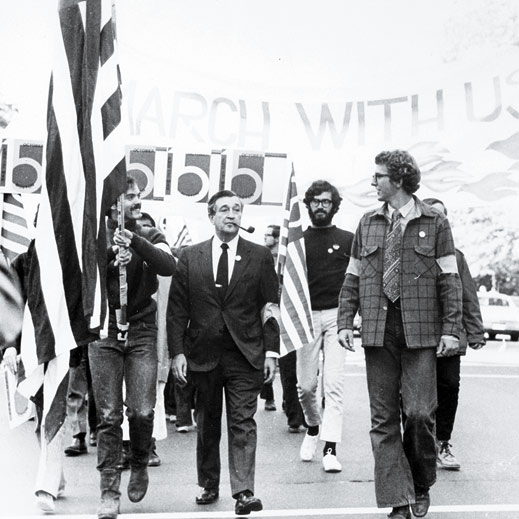Slight Rebellion off Mass. Ave.
In 1968, campus antiwar protests across the country grew combative—most notably at Columbia, where hundreds of students occupied university buildings for a week before being forcibly removed by police. MIT, in contrast, stayed calm: professors still lectured on aerodynamics and electromagnetics; chemicals were pipetted and knobs were turned in research labs across campus.

Four graduate students saw this as a terrible contradiction. MIT was the biggest university defense contractor in the country. Its scientists in the Instrumentation Lab and at Lincoln Laboratory worked daily to develop missile guidance and air defense systems. “We were doing a lot of war research [at MIT], and no one was talking about it,” recalls Ira Rubenzahl, PhD ’71, then a graduate student in physics.
In November of that year, Rubenzahl—along with Joel Feigenbaum and Alan Chodos, two visiting physics graduate students from Cornell, and Jonathan Kabat, PhD ’71, a grad student in microbiology—formed the Science Action Coordinating Committee, or SACC. The group wanted MIT to take responsibility for the science being conducted under its umbrella. And it wanted scientists to give more thought to the end uses of their work.
SACC planned a protest for March 4, 1969, at Kresge Auditorium and outlined its grievances in a poster to promote the event. It noted that MIT was “the country’s 14th largest military contractor for research, development and testing.” It singled out the “special labs” that conducted classified work on campus, and it noted that Lincoln Laboratory and the Instrumentation Lab accounted for more than half of MIT’s total budget—while “educational and general expenses” accounted for only a fourth. The group called for a research stoppage to coincide with the event.
Not long after the formation of SACC, about 50 MIT faculty members formed the Union of Concerned Scientists, which signed an open letter to the community that read in part: “Misuse of scientific and technical knowledge presents a major threat to the existence of mankind.” Like SACC, the Union of Concerned Scientists wanted MIT to trim its military research and focus more on environmental and social research.
Newspapers heralded the approaching event. “Strike to Protest ‘Misuse’ of Science,” reported the New York Times; “Research to Stop March 4,” announced the Tech. As word spread, about 30 other universities organized their own March 4 events. Faculty members and students at Brandeis, Harvard, and Northeastern signed pledges of support.
The support wasn’t universal. Eighteen faculty members, led by physicist Jerrold R. Zacharias, signed a public statement that said the March 4 event “misrepresents the spirit and character of research in a free and academic community.” Nevin Scrimshaw, chairman of the Department of Nutrition and Food Science, said in an interview with the New York Times that the idea of the event was “naïve and hardly useful,” and he issued his own statement in opposition. At Argonne National Laboratory, more than 80 scientists mocked the protest with a 16-hour “work-in.”
By the standards of 1960s campus turmoil, the March 4 event was mild stuff. It included speeches by Noam Chomsky and George Wald and panels on “the responsibility of intellectuals.” The Boston Globe called it “the most orderly … anti-war and anti-government policy demonstration yet seen.”
Research didn’t come to a halt that day. But some classes were only half full, and the 1,200 or so seats in Kresge were filled most of the day. “Everybody was talking about it,” says Rubenzahl.
The activism did lead to some changes. In 1973, MIT severed its affiliation with the Instrumentation Lab (today it’s the Draper Lab, a private entity). It also set up an executive committee to review the operation of the labs and moved all classified research off campus to the Lincoln Lab.
A 2010 Globe article noted that MIT remained one of the top five recipients of Department of Defense funding for university research, receiving more than $750 million per year. And just as in the 1960s, MIT can seem politically reticent. “Until recently, there really hasn’t been a strong activism focus,” says Patrick Brown, a doctoral student in physics and a member of Fossil Free MIT, which opposes investments in fossil fuel companies.
As for SACC, its ambitions were big, but the group itself was fleeting. By 1972, it had disbanded. The Union of Concerned Scientists, on the other hand, still exists. It advocates for clean energy and sustainable agriculture, among other objectives—and now has 400,000 members.
Keep Reading
Most Popular
Large language models can do jaw-dropping things. But nobody knows exactly why.
And that's a problem. Figuring it out is one of the biggest scientific puzzles of our time and a crucial step towards controlling more powerful future models.
The problem with plug-in hybrids? Their drivers.
Plug-in hybrids are often sold as a transition to EVs, but new data from Europe shows we’re still underestimating the emissions they produce.
Google DeepMind’s new generative model makes Super Mario–like games from scratch
Genie learns how to control games by watching hours and hours of video. It could help train next-gen robots too.
How scientists traced a mysterious covid case back to six toilets
When wastewater surveillance turns into a hunt for a single infected individual, the ethics get tricky.
Stay connected
Get the latest updates from
MIT Technology Review
Discover special offers, top stories, upcoming events, and more.